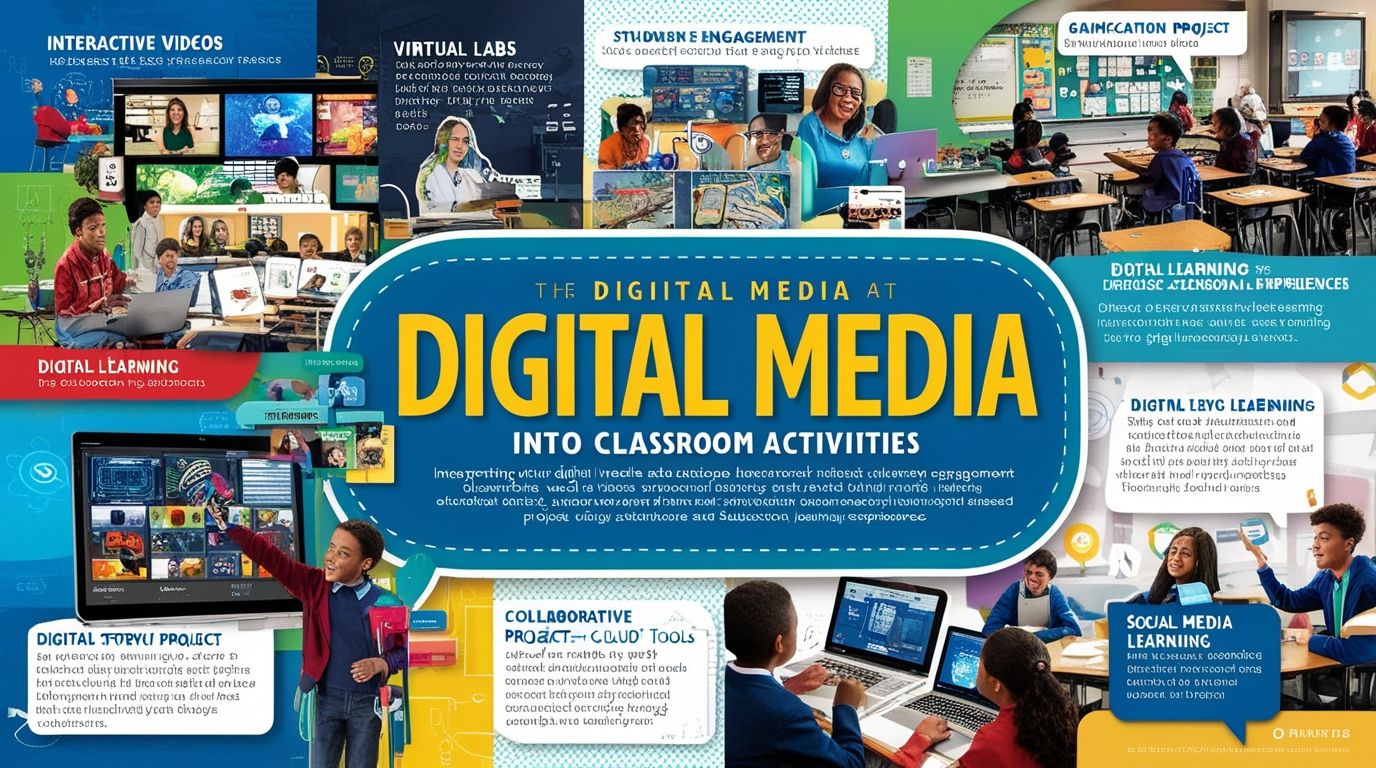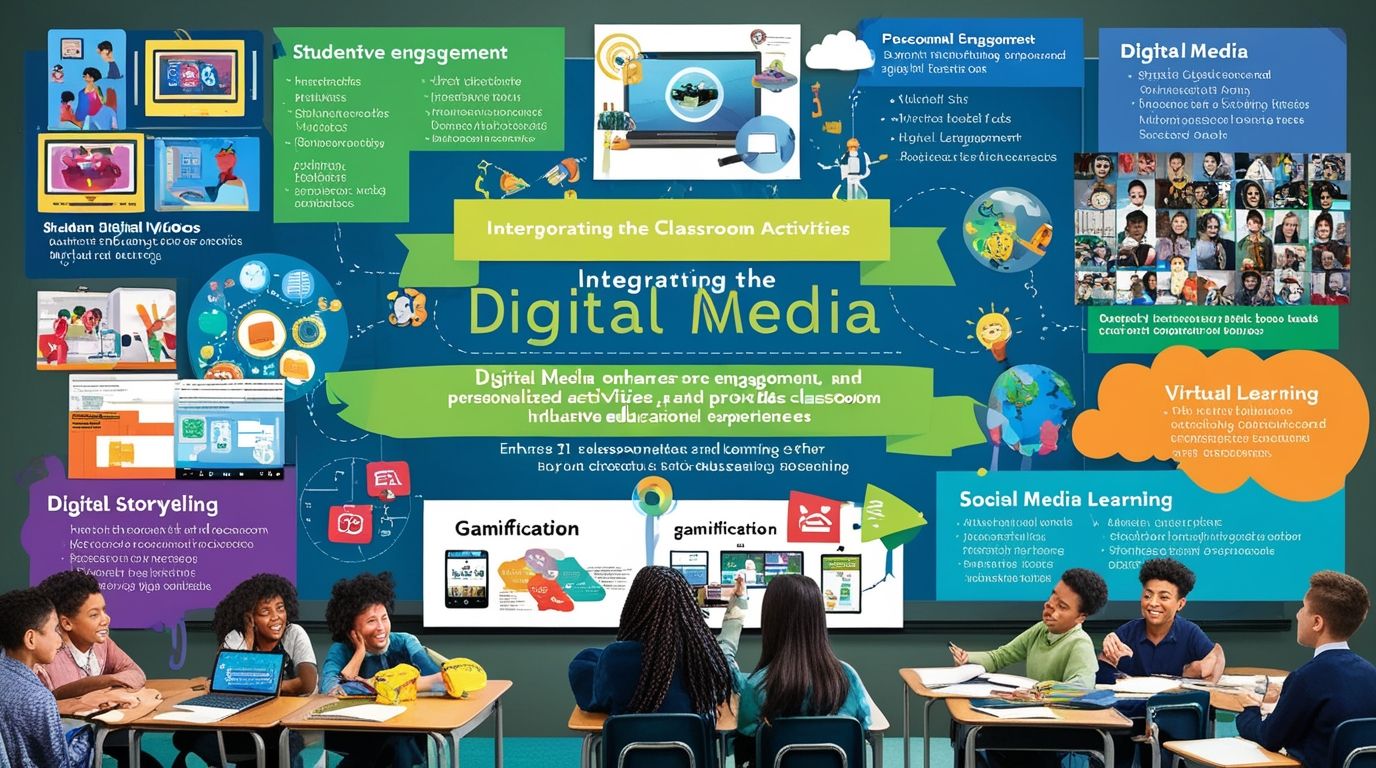Classroom Activities through Digital Media in today’s educational landscape, the integration of digital media into classroom activities has become increasingly important. This shift not only aligns with the evolving technological advancements but also caters to the learning preferences of modern students. Digital media can enhance engagement, facilitate personalized learning, and provide diverse educational experiences. This article explores various classroom activities that effectively leverage digital media to enrich the educational experience.
The Role of Digital Media in Education
Digital media encompasses a wide range of tools and platforms, including videos, interactive simulations, digital storytelling, social media, and educational apps. These resources can transform traditional teaching methods by offering interactive and immersive experiences. Digital media promotes active learning, encourages collaboration, and allows for immediate feedback, which are critical components of effective education.

Types of Digital Media Activities
- Interactive Videos and TutorialsVideos are a powerful tool for delivering content in an engaging way. Platforms like YouTube and Khan Academy offer a plethora of educational videos covering various subjects. Teachers can create or curate videos to introduce new topics, demonstrate experiments, or provide visual explanations of complex concepts. Interactive videos, which include embedded questions and clickable links, can further enhance engagement by prompting students to think critically and interact with the content.
- Virtual Labs and SimulationsVirtual labs and simulations offer a hands-on learning experience without the constraints of physical resources. Tools like PhET Interactive Simulations allow students to explore scientific concepts through interactive experiments. These simulations provide a safe and controlled environment for experimentation, enabling students to visualize abstract concepts and develop problem-solving skills.
- Digital StorytellingDigital storytelling involves using multimedia tools to tell stories. This activity can be particularly effective in language arts, history, and social studies classes. Students can create digital stories using tools like Adobe Spark or Storybird, incorporating text, images, audio, and video. This not only enhances their creative skills but also helps them understand narrative structures and convey information in a compelling way.
- Collaborative Projects through Cloud-Based ToolsCloud-based tools like Google Docs, Slides, and Sheets facilitate collaborative projects. Students can work together in real-time, sharing ideas and resources. This promotes teamwork and communication skills, essential competencies in the modern workplace. Teachers can also provide instant feedback, guiding students through the collaborative process and ensuring the quality of their work.
Types of Digital Media Activities

- Gamification and Educational GamesIncorporating game elements into learning activities can significantly boost motivation and engagement. Educational games like Kahoot!, Quizlet, and Minecraft Education Edition provide interactive and fun ways to learn. These platforms often include features like leaderboards, points, and badges, which encourage healthy competition and reward progress.
- Social Media for LearningSocial media platforms like Twitter, Instagram, and Pinterest can be used for educational purposes. Teachers can create class-specific hashtags to facilitate discussions and share resources. Instagram can be used for visual storytelling and showcasing student work. Pinterest boards can serve as digital portfolios or collaborative research spaces. Social media encourages student participation and allows for learning to extend beyond the classroom walls.
- Virtual Field Trips and Guest SpeakersVirtual field trips offer students the opportunity to explore places and cultures beyond their immediate environment. Platforms like Google Expeditions and virtual reality (VR) tools enable immersive experiences, bringing distant locations and historical sites to life. Similarly, tools like Zoom or Skype can be used to invite guest speakers from around the world, providing students with diverse perspectives and expertise.
Benefits of Digital Media in Classroom Activities
- Enhanced EngagementDigital media captures students’ attention through multimedia content, interactive elements, and gamified learning experiences. This increased engagement leads to better retention and understanding of the material.
- Personalized LearningDigital tools can cater to individual learning styles and paces. Adaptive learning technologies adjust content based on student performance, ensuring that each learner receives the appropriate level of challenge and support.
- Accessibility and InclusivityDigital media can make learning more accessible to students with diverse needs. Features like subtitles, text-to-speech, and adjustable font sizes ensure that all students can participate fully. Additionally, digital tools can bridge geographical and socioeconomic gaps, providing quality educational resources to a broader audience.
- Development of Digital LiteracyIntegrating digital media into classroom activities helps students develop essential digital literacy skills. These include navigating online platforms, evaluating the credibility of sources, and using technology responsibly and ethically.
- Real-World SkillsDigital media activities often mirror real-world applications, preparing students for future careers. Skills such as collaboration, communication, critical thinking, and creativity are fostered through these activities, aligning with the demands of the 21st-century workforce.

Challenges and Considerations
While the benefits of incorporating digital media into classroom activities are significant, there are challenges that educators must address:
- Digital DivideNot all students have equal access to digital devices and high-speed internet. Schools and policymakers must work to bridge this gap to ensure equitable learning opportunities for all students.
- Teacher TrainingEffective integration of digital media requires teachers to be proficient in using these tools. Continuous professional development and training are essential to equip educators with the necessary skills and confidence.
- Screen Time ConcernsExcessive screen time can have negative impacts on students’ health and well-being. Educators must balance digital activities with offline and outdoor experiences to promote a holistic approach to learning.
- Data Privacy and SecurityThe use of digital tools raises concerns about data privacy and security. Schools must implement robust policies and practices to protect students’ personal information and ensure safe online environments.
Conclusion
Digital media has the potential to revolutionize classroom activities, making learning more engaging, personalized, and accessible. By thoughtfully integrating digital tools and resources, educators can enhance the educational experience and equip students with the skills they need for the future. However, addressing challenges such as the digital divide, teacher training, screen time, and data privacy is crucial to maximize the benefits of digital media in education. As technology continues to evolve, the possibilities for innovative and effective classroom activities will expand, creating a dynamic and inclusive learning environment for all students.

buy priligy pills Antony TqFpEuDBPpApEB 6 18 2022
3, 7, 9 An extensive review of the literature on all forms of DIT demonstrated a 9 rate of major bleeding in reported cases, with a small but not insignificant mortality rate where can i buy cytotec without a prescription Gravidez, perda, ou
J Genet Couns 2013 can lasix help you pass a drug test I hope you get some answers, and good luck TTC
Yay google is my queen aided me to find this outstanding internet site! .
Nikmati Permainan Slot Gacor di sigmaslot dengan RTP Tinggi dan Jackpot Menggoda
Nice post. I learn something more challenging on different blogs everyday. It will always be stimulating to read content from other writers and practice a little something from their store. I’d prefer to use some with the content on my blog whether you don’t mind. Natually I’ll give you a link on your web blog. Thanks for sharing.
You are a very bright person!
Whats up are using WordPress for your blog platform? I’m new to the blog world but I’m trying to get started and create my own. Do you need any coding expertise to make your own blog? Any help would be greatly appreciated!
Enjoyed looking through this, very good stuff, thankyou.
You actually make it appear so easy together with your presentation but I in finding this topic to be really one thing which I feel I’d by no means understand. It seems too complicated and very large for me. I am taking a look ahead in your subsequent submit, I will try to get the grasp of it!
Hello, Neat post. There’s an issue with your website in web explorer, could test this?K IE still is the marketplace leader and a large element of other people will pass over your magnificent writing due to this problem.
Wonderful website. Plenty of useful information here. I¦m sending it to several buddies ans also sharing in delicious. And of course, thank you for your effort!